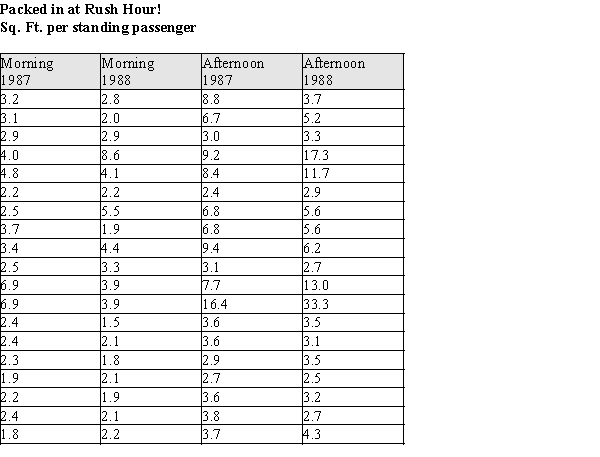Exhibit 3-2
In 1990 the New York Times reported the average number of square feet per standing passenger in 1987 and 1988 for 19 subway stops. Although the sampling method was not reported, we will presume that these data represent a random sample of days during the morning and evening rush hours. The NYC Transit Authority managers attempted to improve the space problem on subway cars (more space is better--trust us!) by adding cars to trains during the rush hours. They gathered the 1988 data to check on their efforts after one year. The data are in the table below. 
-Refer to Exhibit 3-2.
The MTA guidelines in 1987 specified a minimum of 3 square feet per standing passenger. The engineers would like to report standardized measures (z-scores) of this target value. That is, for each year and time of day, they will report how far away the target value of 3 feet is relative to the different distributions.
(a)Consider the original passenger space data for the morning rush in 1987, used in Exhibit 3-2. What are the mean and standard deviation for the sample?  =
=
s =
(b)How many standard deviations above/below the mean is the target value of 3 feet for the distribution in part (a)?
Definitions:
Operating Assets
Assets such as property, plant, and equipment used in the daily operations of a business to generate revenue.
Turnover
The total sales made by a business in a specific period, or the rate at which employees leave and are replaced within a company.
Return On Investment (ROI)
A financial metric used to evaluate the efficiency of an investment, calculated by dividing the benefit (return) of an investment by its cost.
Net Operating Income
The total earnings generated from a company's operations, excluding taxes and interest.
Q2: For an older client age 75) we
Q2: The point estimate a + bx* is
Q2: A study was carried out to see
Q3: Data from a poll of adults aged
Q8: Consider the following five scatterplots. All are
Q14: The standard error of <img src="https://d2lvgg3v3hfg70.cloudfront.net/TB7677/.jpg" alt="The
Q17: Fifty-five people volunteered to participate in a
Q41: Health Care Systems, Inc. rolls out an
Q45: The spread of the sample mean decreases
Q159: When calculating the present value of an